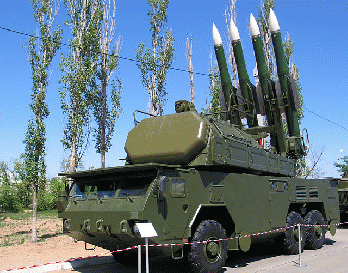"B: Uh-huh.
"C: Ok. Well, if they come in the airport, will fight at the airport. What else can we do?
"B: Ok. I got you."
Although it's difficult to know precisely what these callers are discussing, the conversation seems to refer to a potential battle for an airport, not the deployment of a Buk missile system.
Also, if Ukrainian forces had penetrated that deep into rebel territory, it is difficult to exclude that a Ukrainian Buk battery might have traveled along the southerly route H-21, which skirts Donetsk and then heads east toward the JIT's claimed firing site in a field near the town of Pervomaiskyi. H-21 then bends north toward Luhansk airport and the city of Luhansk.
The Ukrainian Buks
The JIT video report on the MH-17 case, which was released on Wednesday, also didn't address questions about the location of several Ukrainian Buk missile batteries that Dutch (i.e., NATO) intelligence placed in eastern Ukraine on July 17, 2014, the day that MH-17 was shot down. A finding from the Dutch intelligence service, MIVD, released last October, said the only high-powered anti-aircraft missile systems in eastern Ukraine at that time, capable of bringing down MH-17 at 33,000 feet and killing all 298 people onboard, belonged to the Ukrainian military, not the rebels.
Although the location of the Ukrainian Buk systems would seem to be crucial to the investigation -- at least in eliminating other suspects -- JIT operates under an agreement with the Ukrainian government that lets it veto the release of information. Ukraine's SBU intelligence service, which represented the Kiev government in the JIT, also has among its official responsibilities the protection of secret information that could be damaging to Ukraine.
Regarding JIT's claim that the Buk missile system crossed over from Russian territory, the video report states: "All telecom data and intercepted telephone calls that have been examined by the investigation team demonstrates that the Buk/TELAR (the self-contained operating system) was brought into Ukraine from the Russian Federation."
But as evidence the JIT cites one phone intercept, which -- according to the JIT's translation -- does not use the word Buk though referencing a piece of equipment that can move on its own or be transported by truck. That could be a Buk system but could apply to many other weapons systems as well.
In the intercepted call, one speaker said, "it crossed, crossed the line." The narrator of the JIT video report then adds, "The Buk/TELAR crossed the line, in other words, it passed the border." But there are two assumptions here: that the unidentified weapon is a Buk and that the "line" means border. That could be the case but other interpretations are possible.
Another key point, the disputed location of the so-called "getaway" video of a Buk missile system missing one missile, is simply asserted as fact without an explanation as to how the JIT reached its conclusion placing the location near Luhansk.
While the Western mainstream media has given the JIT great credibility, the JIT itself has acknowledged a dependency on Ukraine's SBU, which shaped the inquiry by supplying its selection of phone intercepts.
Yet, the SBU is far from a neutral party in the investigation, nor does it have clean hands regarding the Ukrainian civil war that followed a U.S.-backed putsch ousting elected President Viktor Yanukovych on Feb. 22, 2014, and sparking an uprising among ethnic Russian Ukrainians who represented Yanukovych's political base in the east and south.
Since then, the SBU has been on the front lines of crushing the rebellion by using controversial tactics. In late June 2016, the United Nation's Assistant Secretary-General for Human Rights Ivan Simonovic accused the SBU of frustrating U.N. investigations into its alleged role in torture and other war crimes.
(Note: You can view every article as one long page if you sign up as an Advocate Member, or higher).






